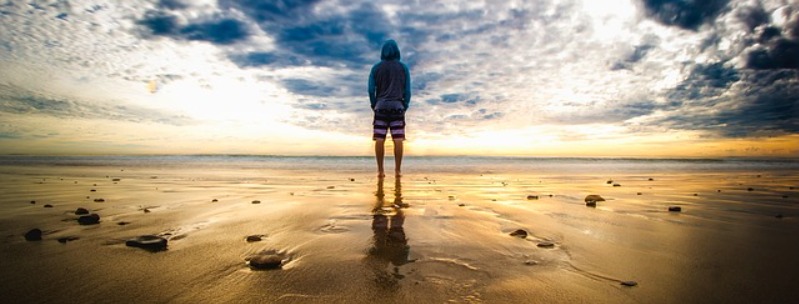Best California Beaches For Kids
Publicized and idealized all over the world, California really does live up to the myth. California is one of the most stunning places to wake up in the world. Every morning, when the sun rises and colors the sky pink, orange, and purple, our landscapes could not be more beautiful – especially along the coast.
More than just a terrestrial paradise of sun, sand, and surf, it has high mountain ranges, fast-paced glitzy cities, primeval old-growth forests, and vast stretches of deserts. Add some palm trees, curious seagulls, ocean waves, and surfers, and the scene becomes even more beautiful. These are just 13 of the many beaches where you should get up early to watch the sunrise.
Carmel Beach
Set on gently rising headlands above a sculpted rocky shore, Carmel is well known for its ridiculously inflated real-estate prices, neat rows of quaint shops and miniature homes along Ocean Avenue, and a largely untouched coastline.
The area’s natural appeal is much greater than its cultural offerings.
Carmel Beach, for one, is a tranquil cove of blue water bordered by soft white sand and cypress-covered cliffs (the tides are deceptively strong and dangerous, so be careful if you chance a swim).

Point Lobos State Reserve, two miles south of Carmel on Hwy-1 (daily: summer 9 am-6:30 pm; winter 9 am-5 pm; $3 per vehicle; ), has plenty of natural attractions to support its title of “the greatest meeting of land and water in the world.”
Spread along 1250 acres, and with more than 250 bird and animal species along the area’s hiking trails, the sea here is one of the richest underwater habitats in California.
Gray whales are often seen offshore, migrating south in January and returning with young calves in April and early May. Because the point juts so far out into the ocean, chances are good of seeing them from as little as a hundred yards away.
Hermosa Beach
In Hermosa Beach (Hermosa means beautiful in Spanish) there are one-and-a-half miles of the prettiest, cleanest beach in Southern California.
Have fun with volleyball, paddleball, or beach ball, while creating a golden tan or toning up. Surfboarding, skateboarding, or boogie boarding are all here.
Other options are jogging, skating, or biking along the Strand, the paved strip paralleling the beach, and connecting Hermosa with the neighboring beach cities. The Strand also boasts an architectural stylist’s smorgasbord of delights in multi-city residences from Art Deco to Victorian.
After hours, it’s time to start visiting the many restaurants in Hermosa Beach. From the Il Boccaccio to the Good Stuff on the Strand, taste treats are in store for almost any type of food.
After dinner, find a choice of entertainment at the nationally famous Comedy and Magic Club, dance at the Lighthouse, or just relax and visit other nightclubs in the area.
Besides year-round beach activities, winter skiing is only a few hours away at Big Bear, Mt. Baldy, or Lake Arrowhead. Several National Forests are within a short drive of Hermosa Beach with all their coniferous and sylvan atmosphere and recreational possibilities.
Long Beach
Thanks to a billion-dollar clean-up, downtown Long Beach is not the seedy stomping grounds of off-duty sailors that it was twenty-odd years ago.
Pine Avenue is an enjoyable stretch of restored architecture and bargain antique stores, but the only reason most tourists cross to the far side of LA’s massive harbor is to see the Queen Mary. The Cunard flagship from the 1930s until the 1960s, the Queen Mary is now a luxury hotel, and guided tours present a sentimentalized version of its days of elegance and refinement.
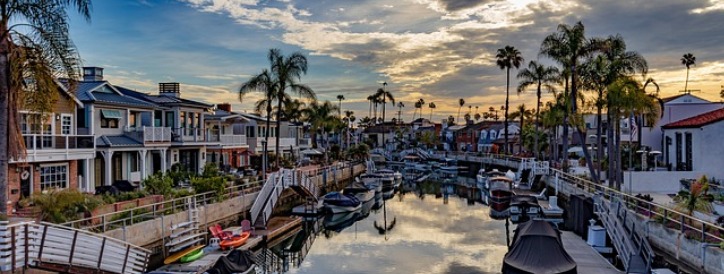
The huge geodesic dome nearby housed Howard Hughes’s Spruce Goose airplane until it was sold and moved to Oregon in 1992, but this tourist loss has been more than remedied by the opening of the Aquarium of the Pacific along shoreline Drive, a terrific exploration of aquatic flora and fauna in three distinct geographic and climatic zones from around the world.
Built on or near the sand in neighborhoods with narrow streets barely wide enough for cars to pass in some places, Naples and Belmont Shore are two beach communities on the south end of Long Beach near the Orange County border.
Tucked away in residential neighborhoods that have nothing to sell, little parking, and scarce public facilities such as restrooms, are several scenic, quiet and quaint beaches.
In downtown Long Beach, there are public beaches with large parking lots south of the Convention Center and west of Ocean Boulevard.
As you drive along the coast of Long Beach, don’t be fooled by the sight of the bright pastel islands just offshore; far from natural, they’re actually oil-drilling platforms in disguise.
Malibu
Malibu, at the top of the bay twenty miles north of Santa Monica, is a whole other world, its beach-colony houses owned by those famous enough to need privacy and rich enough to afford it.
Surfrider Beach here was the surfing capital of the world in the 1950s and early 1960s, as seen in the Beach Blanket Bingo movies of Annette Funicello and Frankie Avalon (the surf is at its best in late summer).
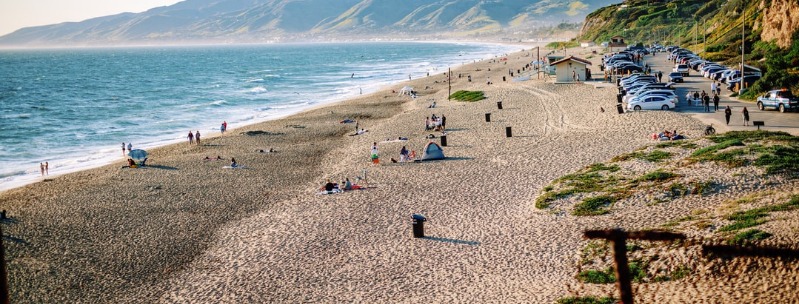
Just beyond is Malibu Lagoon State Park, a nature reserve and bird refuge, and nearby is the Adamson House, a stunning Spanish Colonial home, mixed with Moorish and Mission Revival elements, featuring opulent decor and colorful tilework.
Most Malibu residences are tucked away in an insular community in the narrow canyons on the fringes of town. There’s very little to see, despite tourists’ futile attempts to peek into the exclusive Malibu Colony celebrity retreat, located along an unmarked stretch near PCH.
Five miles along the coast from Malibu Pier, Zuma Beach is the largest and most crowded of the Los Angeles County beaches.
Adjacent Point Dume State Beach, below the imposing promontory of Point Dume, is a lot more relaxed.
Pacific Grove
A few miles north of Monterey along the peninsula, Pacific Grove – or “Butterfly Town USA,” as it likes to call itself – began as a campground and Methodist retreat in 1875, where Christian revivalists prohibited booze, bare skin and reading the Sunday newspapers, and which still holds ornate wooden cottages from those long-forgotten days.
One of the few other reminders of that pious period is the Gothic Revival church St Mary’s by the Sea, Central Ave at 12th Street, an 1887 redwood marvel with a signed Tiffany window near the altar.
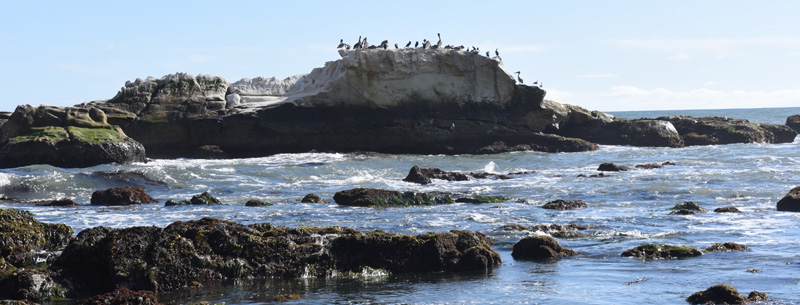
Ocean View Boulevard circles the coast around the town, passing the headland of Lovers Point – originally called Lovers of Jesus Point – where preachers used to hold sunrise services.
Surrounded in early summer by the colorful red-and-purple cloaks of blooming ice plants, it’s one of the peninsula’s best beaches.
Every year, from November through early March, hundreds of thousands of golden Monarch butterflies come to Pacific Grove to escape the winter chill, forming orange and black blankets on the Butterfly Trees, on Ridge Road, a block west of Lighthouse Avenue.
At the end of the avenue, near the tip of Monterey Peninsula, stands the 150-year-old Point Pinos lighthouse (Thurs-Sun 1-4 pm; free), the oldest continuously operating lighthouse on the California coast and, perhaps contrary to grander expectation, is basically a charming little farmhouse with a revolving light poking out from its roof.
Pismo Beach
Just outside San Luis Obispo, on Pismo’s 23-mile stretch of prime beachfront, flip-flops are the shoes of choice, and surf wear is the dominant fashion. It’s all about beach life here, so bring your bathing suit, your board, and a good book.
If building sand castles or tanning isn’t your idea of a tantalizing time, you can explore isolated dunes, cliff-sheltered tide pools, and old pirate coves.
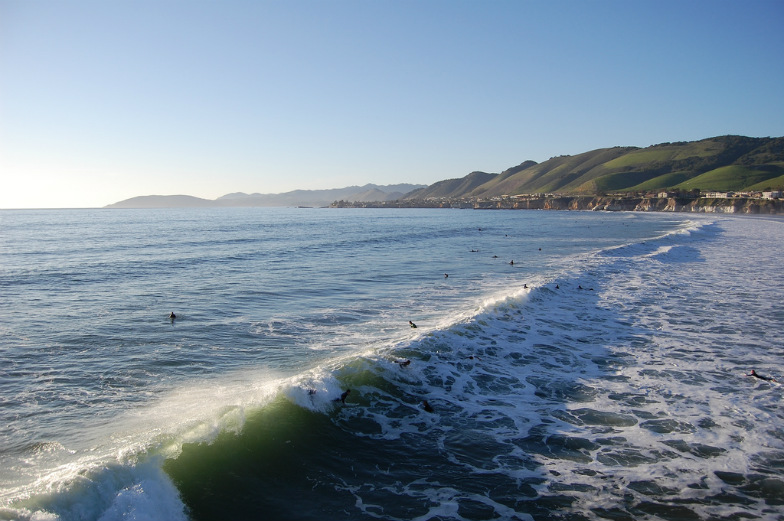
Bring your dog (Fido’s welcome here) and play an endless game of fetch. Or go fishing – it’s permitted from Pismo Beach Pier, which also offers arcade entertainment, bowling, and billiards.
Pismo is also the only beach in the area that allows all-terrain vehicles on the dunes.
Stunning views of the Pacific Ocean are the trademark of Pismo Beach. As you veer around Highway 101 on the Central Coast, you’ll suddenly notice hotels situated on cliffs overlooking the water. Beauty and the beach: it’s the stuff travelers’ dreams are made of.
Because the town itself consists of little more than tourist shops and surf-and-turf restaurants, nearby San Luis Obispo is a far more charming place to stay. But if all you want are a few lazy days on a beautiful beach at half the price of an oceanfront room in Santa Barbara, Pismo is a perfect choice.
San Diego Beaches
Relatively free from smog and byzantine freeways, San Diego, set around a gracefully curving bay, represents the acceptable face of southern California.
Ocean Beach, six miles northwest of downtown, rivals Pacific Beach in its surfing and party atmosphere, although Ocean Beach has a more down-to-earth, bohemian feel, and is replete with excellent secondhand music shops.
North of Ocean Beach, you come to Mission Bay and San Diego’s most popular tourist attraction.
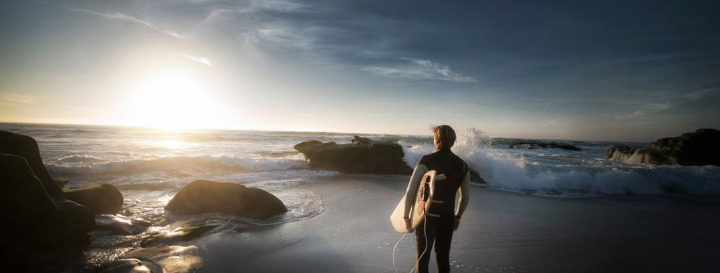
Exhibits and events at Sea World range from “performances” by killer whales and dolphins to the eerie sight of the heads of hundreds of moray eels protruding from the hollow rocks of the “Forbidden Reef.”
Anyone of a nervous disposition, or with a physique inappropriate for bathing apparel, might find nearby Mission Beach – the peninsula that separates Mission Bay from the Pacific Ocean – and its seamless northern extension, Pacific Beach, an intimidating spot, with scads of scantily clad torsos and surfboard-clutching hunks.
A more pretentious air prevails in La Jolla, an elegant beach community just to the north that mystery writer Raymond Chandler once described as “a nice place – for old people and their parents.”
The popular La Jolla Cove, with clear waters, is perfect for snorkeling, as long as you can secure a parking space.
San Luis Obispo
San Luis Obispo, 160 miles north of Santa Barbara and halfway between LA and San Francisco, is a few miles inland but makes the best base for exploring the surrounding coastal regions.
Still primarily an agricultural market center, it holds more nineteenth-century architecture than any other Californian city (especially around Buchon Street), plenty of good restaurants, a couple of pubs, and – outside summer holiday weekends – plenty of accommodation.
The compact core of San Luis is eminently walkable, centered around the late eighteenth-century Mission San Luis Obispo de Tolosa, a dark and unremarkable church that was the prototype for the now ubiquitous red-tiled roof, developed to replace the original, flammable thatch in response to Native American arson attacks.

Between the mission and the visitors center, Mission Plaza‘s terraces step down along San Luis creek, along which footpaths meander, crisscrossed by bridges every hundred feet and overlooked by shops and outdoor restaurants on the south bank.
The undeniable highlight is the stunning pink Fremont Theater, 1035 Monterey St, an Art Deco marvel that becomes a riot of splashy neon at night and still plays movies.
Higuera Street, a block south of Mission Plaza, is the main drag, and springs to life on Thursday afternoons for the Farmers’ Market, when the street is closed to cars and filled with vegetable stalls, mobile barbecues, and street-corner musicians.
Santa Barbara
The six-lane coastal freeway that races past oil wells and offshore drilling platforms slows to a leisurely pace a hundred miles north of Los Angeles at Santa Barbara.
Beautifully sited on gently sloping hills above the Pacific, the town’s ubiquitous red-tiled roofs and white stucco walls of its low-rise buildings form a backdrop to some fine Spanish Revival architecture, while the golden beaches are wide and clean, lined by palm trees along a curving bay.

Although a large portion of downtown has been replaced by a vast, upscale shopping mall, Santa Barbara has managed to retain its quaintly upscale yet relaxed character.
The mission-era feel of Santa Barbara is no accident. Following a devastating earthquake in 1925, the entire town was rebuilt in the image of an apocryphal Spanish Colonial past, with numerous arcades linking shops, cafes, and restaurants, and a pedestrian-friendly layout that serves visitors well – a far cry from LA’s all-consuming auto-worship.
State Street leads half a mile down from the town center to the wooden Stearns Wharf. Built-in 1872, it was nearly destroyed in November 1998, when a third of the pier was engulfed in flames; restoration efforts have now made it home to an array of shopping stalls and food vendors, with magnificent beaches stretching in either direction.
Santa Catalina Island
The enticing island of Santa Catalina, twenty miles offshore, has been in private ownership since 1811 when the resident Gabrieleno Indians were forced to resettle on the mainland.
It remains a wilderness, devoted to the conservation of unique species such as the Catalina shrew (so rare that it’s only been sighted twice), and tourism has been held largely at bay.
Hotels are unobtrusive among the whimsical architecture, and cars are largely forbidden; the two thousand islanders walk, ride bikes, or drive electric golf carts.
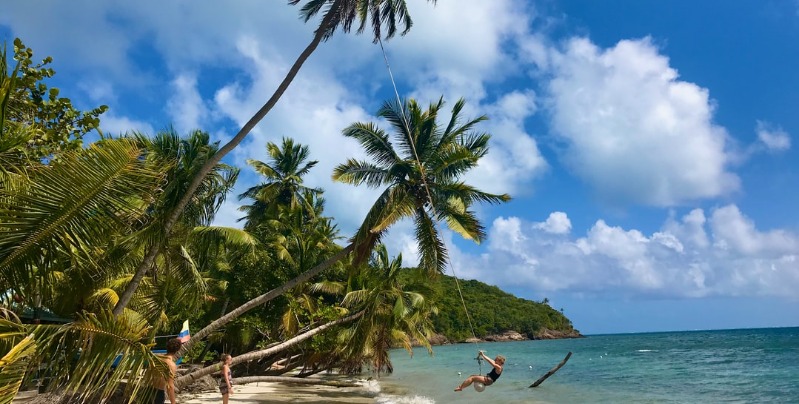
The island’s one town, Avalon, can be fully explored on foot in an hour, and you can rent bikes at a stand on Bay Shore Drive. Pick up a map at the Chamber of Commerce, at the foot of the ferry pier, and begin at the sumptuous Art Deco Avalon Casino, built in the 1920s by William Wrigley Jr (of the Chicago chewing-gum dynasty and one-time owner of the island), which runs regular movie showings and irregular silent film displays.
The collections at the adjoining museum include Native American artifacts from Catalina’s past.
Hotel accommodation in Avalon is much in demand and pricey – upwards of $95: the least expensive is usually the Atwater ($50-75) and the most, the sumptuous, six-room Inn on Mount Ada ($200-250), whose sweeping ocean views once belonged to Wrigley himself.
The only budget options are one mountainside and three seaside campgrounds ($12 per person, kids $6).
Santa Cruz
After the overcharged tourism of Monterey, the unassuming community of Santa Cruz, 75 miles south of San Francisco, comes as a surprise.
Although in many ways the quintessential Californian coastal town, spread at the foot of thickly wooded mountains beside a clean sandy beach, it has grown considerably in the last few years, having recovered from the destruction wrought by the 1989 earthquake.
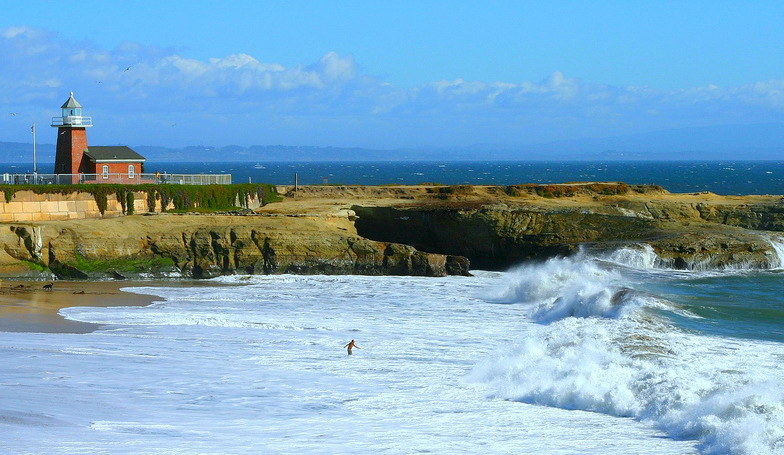
The Santa Cruz Boardwalk, one of the last surviving beachfront amusement parks on the west coast, is the main focus for visitors. The star attraction is the 80-year-old Giant Dipper, a wild and rickety wooden roller coaster that has been ridden by more than 45 million people.
The beach next to the boardwalk is good but can get rowdy (and dirty). For more peace and quiet, follow the coast out of town to one of the smaller beaches such as Capitola or New Brighton.
From West Cliff Drive, you’ll see some of the biggest waves in California, not least at Steamer Lane, beyond the Municipal Pier.
Cowell’s Beach, just north of the Municipal Pier, is the best place to give surfing a try.
A clifftop cycle path runs two miles to Natural Bridges State Beach, where waves have cut holes through the coastal cliffs, forming delicate stone arches.
Santa Monica
Immediately north of Venice, Santa Monica is the oldest and biggest of LA’s resort areas, perched on palm-tree-shaded bluffs, or “the palisades,” above the blue Pacific.
The real focal point of Santa Monica life is on the beach and around the once-decaying and recently refurbished Santa Monica pier.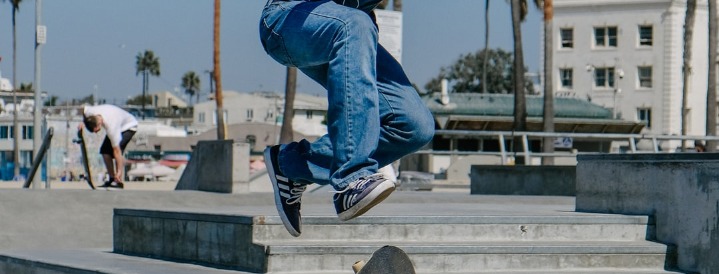
Although the familiar thrill rides of Pacific Park, the pier’s walled-off amusement zone, may first attract the eye, save your money for the UCLA Ocean Discovery Cente, just below the pier at 1600 Ocean Front Walk, where you can find out about local marine biology and get your fingers wet touching sea anemones and starfish.
The grand beach houses just to the north of the pier were known as Hollywood’s “Gold Coast”; the largest, now the Sand and Sea beach club, was built as the servants’ quarters of a massive 120-room house, now demolished, that belonged to William Randolph Hearst.
Five miles north along the curving Pacific Coast Highway (PCH) from Santa Monica, a huge mock French chateau inadvertently marks the easily missed entrance to the opulent Getty Villa, 17985 PCH, the original site of the Getty museum.
Venice Beach
Venice was laid out in the marshlands of Ballona Creek in 1905 by developer Abbot Kinney as a romantic twenty-mile network of canals, lined by sham palazzos and waterfront homes.
A fair bit of the original plan survives, and the pseudo-European atmosphere has made Venice one of the coast’s trendier spots.
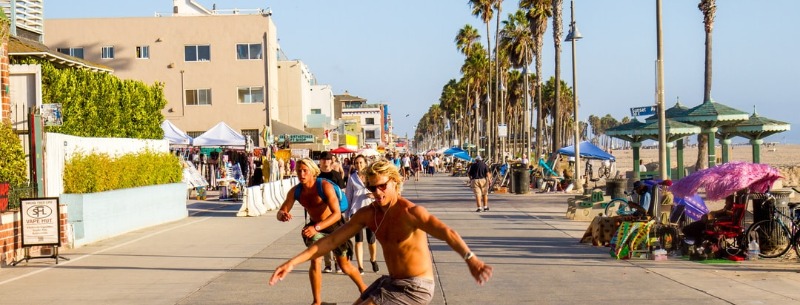
Chic cafes and restaurants abound near the beach, an alternative art scene centers on the Beyond Baroque Literary Arts Center, 681 Venice Blvd, and the easy, laid-back vibe attracts countless slackers and slummers.
The town’s main artery, Windward Avenue, runs from the beach into what was the Grand Circle of the canal system.
Southerly Venice Beach itself is the reason most people come here.
Nowhere else does LA parade itself quite so openly as along the wide pathway of Venice Boardwalk, ever packed with jugglers, fire-eaters, roller-skating guitar players, and people-watchers, though increasingly on the verge of gentrifying into a corporate-sanitized shopping district.
South of Windward is Muscle Beach, a legendary outdoor weightlifting center where serious-looking hunks of muscle pump some serious iron, and high-flying gymnasts swing on the adjacent rings and bars.
At night Venice Beach is alive with street gangs and drug dealers. Walking on the beach after dark is illegal, and you should be very cautious in the vicinity.
